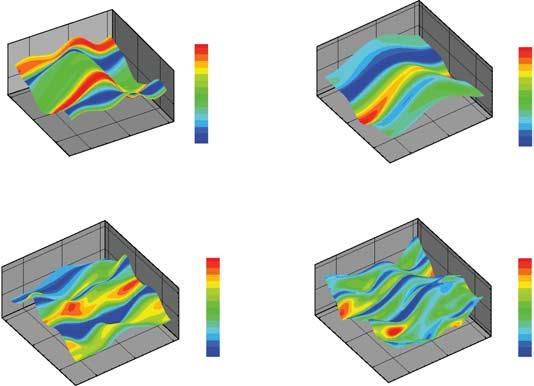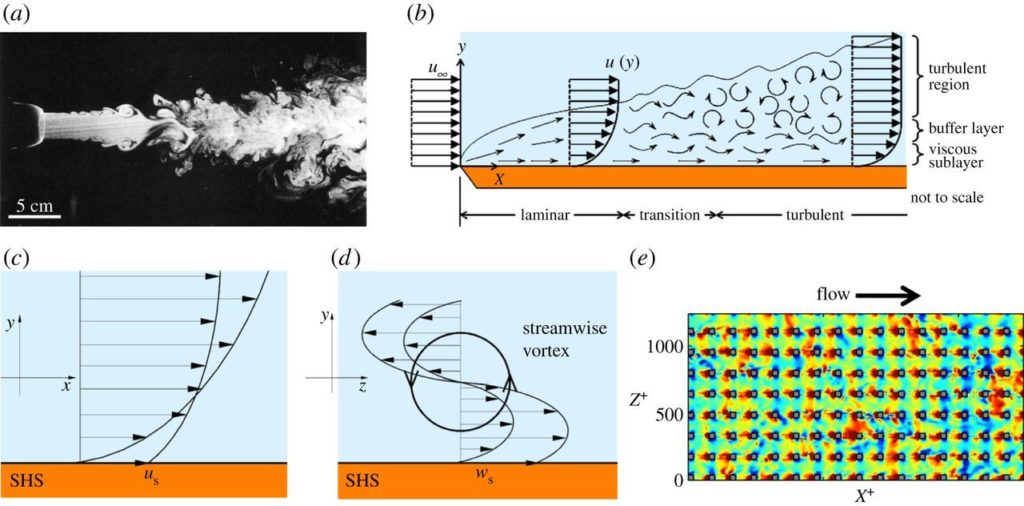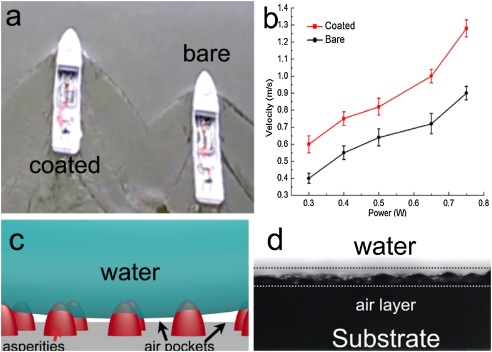Keywords: Compliant compliance porous porosity permeability surfaces coatings pressure velocity waves wall damping turbulent drag reduction super hydrophobic surface
This section will be completed later
Compliant surfaces or coatings
A compliant surface (or coating) is another technique for reducing hydraulic or aerodynamic drag. It is based on a dynamic action of pressure waves applied to a surface in contact with the flow. Following a force exerted punctually by the pressure wave, the surface is deformed, taking on a new state when the intensity of this force changes (amplification or attenuation). It is the dynamic interaction between pressure waves and the displacement of the surface that allows pressure waves to attenuate or increase the effects of turbulence generating these pressure waves. This results (in the first case) in a reduction in turbulent intensity and a reduction in energy losses. In the case of an external (open) flow, this technique will allow a reduction in the deceleration of an object in contact with a gas or a liquid or a reduction in the driving power at the origin of its displacement. In the case of an internal flow (closed), this will allow a reduction in pressure losses in a gas or liquid pipe and, consequently, a reduction in compression or pumping power. It is relatively clear that an adaptation of the deformable surface is required so as to be able to respond synchronously to the action of pressure waves. In this respect, the rigidity and density of the deformable material are critical parameters.

Image from article: Turbulence over a compliant surface: numerical simulation and analysis. Article by Xu, Rempfer and Lumley. J. Fluid Mech.(2003),vol.478,pp.11–34.c
This paper presents some results from a numerical investigation of turbulent channel flow in the presence of a compliant wall. The compliant wall is modelled as a homogeneous spring-supported plate.
_
Porous surfaces or coatings
A porous surface (or coating) is a technique similar to the previous one to reduce hydraulic or aerodynamic drag. It is based on a dynamic action of velocity waves on a coating in contact with the flow. Following an action generated punctually by a velocity wave, the coating absorbs (permeability) and partially retains (porosity) the fluid. In a second phase, the surface receives a surplus or rejects part of the fluid following a modification of the intensity of the velocity wave (amplification or attenuation). It is the dynamic interaction between velocity waves and the absorption characteristics of the surface that allows velocity waves to attenuate the effects of the turbulence generating these velocity waves. This results in a reduction in turbulent intensity and a decrease in energy losses. As in the case of a compliant surface, it will be possible to reduce the energy consumption in the case of an external flow as in the case of an internal flow. It is relatively obvious that an adaptation of the porous surface is required so as to respond synchronously to the action of velocity waves. The permeability, the porosity and the geometrical characteristics of the wall coating are determining
_
Super hydrophobic surfaces (SHS) lead under certain geometrical and hydraulic conditions to flow drag reduction with laminar and turbulent flows. A super hydrophobic surface is some sort of porous coating in one extreme condition in a sense that a porous coating is addressed to a volume and SHS is addressed to a surface.
_

Image from article: Bioinspired surfaces for turbulent drag reduction. Article by Golovin, Gose, Perlin, Ceccio and Tuteja
This study consider super hydrophobic surfaces. It shows how the velocity profile (lower left) and the stream wise vortices (lower middle) are modified near to the wall and how it leads to flow drag reduction in turbulent flow. Here the study is made in the case of a flow development (upper right)
_

Image from article: Scalable super hydrophobic coating with controllable wettability and investigations of its drag reduction. Article by Wang, Tang, Cai, Xiong October 2018. Colloids and surfaces A: Physicochemical and engineering aspects. Vol 555, Pages 290-295
In this study, steel surface was sprayed with suspension that contained PMMA and hydrophobic nanoscale silica with different sizes, shapes and intervals.
Sailing test and rotary disc test, results showed that super hydrophobic could efficiently reduce the drag force under low fluidic condition